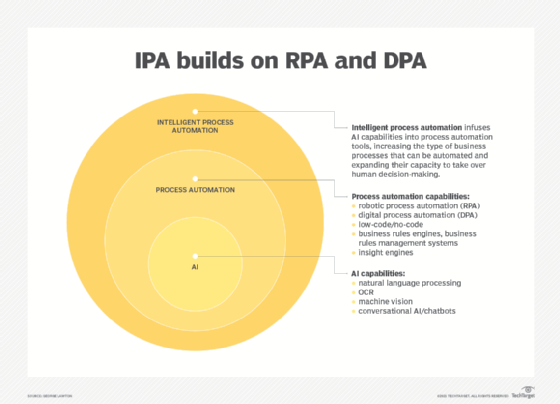What is intelligent process automation (IPA)?
Intelligent process automation (IPA) is a combination of technologies used to manage and automate digital processes. IPA can increase operational efficiency, worker performance and customer response efficiency. It also reduces operational risk, with the goal of creating an effective operations environment.
IPA is designed to assist human workers by doing manual, repetitive and routine tasks that were previously performed by humans. Technologies combined in IPA include robotic process automation (RPA), AI, machine learning (ML) and digital process automation (DPA). With these technologies -- especially AI and ML -- an IPA tool can learn how to adjust and improve the process flow over time to create an intelligent automation process.
IPA is important in automating larger portions of enterprise jobs. It enables users to scale up their automation use cases more quickly and easily and carry out more sophisticated tasks, such as automatically detecting objects on a screen or using technologies like natural language processing (NLP).
Components of intelligent process automation
Understanding what IPA is and what it can do starts with what technologies are used to make it possible. The following technologies are commonly included in IPA processes:
- AI. AI is the simulation of human intelligence processes by machines, especially computer systems. AI can analyze data faster than humans can while recognizing patterns and learning from past choices.
- ML. Machine learning is a type of AI that helps software applications become more accurate at predicting outcomes. ML algorithms use historical data as input to predict new output values.
- RPA. RPA is a software automation tool that can help automate labor-intensive tasks. It can perform rule-based tasks and typically includes AI and ML.
- DPA. DPA is software used to automate tasks with the goal of completing and optimizing a workflow. DPA automates, or partially automates, tasks that typically need human interaction.
- NLP. NLP is a type of AI that enables computers to understand language like humans do.
- Cognitive agents. Cognitive agents are virtual agents that combine ML and NLP to learn from data sets and to complete tasks.
- Computer vision. Computer vision is a process that can scan documents and convert them to text. It uses technologies like optical character recognition (OCR).
- Process mining. Process mining is a technique that interprets logs from enterprise applications -- such as customer relationship management and enterprise resource planning platforms -- to identify the steps in common business processes, detect variations and prioritize areas of improvement.
By combining all these technologies, an enterprise can automate labor-intensive tasks while still being adaptable to change.

IPA vs. RPA: What's the difference?
IPA and RPA are similar processes. However, IPA covers a larger scope of work than RPA. RPA is generally meant to be used for defined, rule-based processes. Comparatively, IPA is used for more complex operations that benefit from the use of AI, ML, NLP, predictive analytics and other technologies, including RPA.
IPA can also handle more types of data formats while enabling more types of intelligent decision-making. Both IPA and RPA are valuable and have their own best use cases. For example, RPA is more useful when the tasks it needs to handle are predictable, structured, repetitive and rule-based. IPA is more suited to tasks that are more complex, require pattern recognition and learning, and involve unstructured or semistructured data.
IPA, however, requires the foundation of RPA. In addition, an effective IPA strategy requires IT ;and data science teams to collaborate more deeply than is necessary with RPA.
IPA is also similar to business process automation, which can be used as another analogous term.
Benefits of IPA
The benefits of using IPA include the following:
- Automation of previously manual and repetitive tasks.
- Optimization of worker productivity by freeing them of routine tasks.
- Coordination of work between software systems and people.
- End-to-end visibility of processes and customer journeys.
- Improvement of customer experience.
- Reduction of processing errors.
- Decreasing operational costs and transaction processing time.
- Easier adaptation to changes in process.
Current and future use cases
Because IPA and RPA are similar in nature, as soon as an organization has a stable RPA environment, it can extend that environment into IPA -- using the previous environment as a foundation. Using IPA, organizations can replace previously manual and repetitive tasks, interpret text with NLP, make machine-based decisions with ML, manage tracking of handoffs between systems and people, and offer customers suggestions using cognitive agents.
In the past, there was more of an argument about whether an organization should use IPA versus RPA. Now, however, it's accepted that organizations could use IPA to cast a broader strategy around RPA. Rather than having all the technologies involved with IPA deployed individually, an IPA tool can tie them together to form more agile and stable business operations.
An example of an IPA use case would be when an organization needs to gather data for a customer, which would normally take a large amount of time. An IPA tool could interpret the needed text, make decisions on how to share that data, and offer suggestions to the customer based on their input.
Another example is in healthcare, where an IPA tool could be used for patient scheduling and billing by checking insurance and handling claims submissions. It could also be used in the same setting to extract data from physical notes or in other medical fields to analyze medical images.
Insurance departments could use an IPA tool to pull text from physical forms while processing claims. The shipping industry could use an IPA tool to analyze shipping data to optimize shipping routes and schedules and reduce bottlenecks.
Market outlook and leading tools
According to a report by Straits Research, the intelligent process automation market size was valued at $14.4 billion in 2023. By 2032, that number is expected to grow to an estimated $42.12 billion.
IPA is becoming increasingly popular as more vendors begin to offer products and workflow automation tools. The following is a sample of intelligent RPA products:
- Automation Anywhere. The company's cloud-based Automation Success Platform integrates RPA features with IPA qualities such as AI, ML and language understanding to process unstructured data and understand natural language.
- IBM. The tech giant's Robotic Process Automation software combines traditional RPA features with AI and NLP.
- Microsoft. Power Automate is built on Azure to provide capabilities including RPA and application programming interface integrations, intelligent document processing, AI and OCR.
- Pegasystems. The low-code Pega Robotic Automation tool performs process automation and builds on top of an RPA feature set to provide AI and real-time analytics integrations.
- UiPath. The company's Business Automation platform supports IPA features, such as document understanding and AI-enabled task automation for desktop and web applications.
Many IPA tools start with using RPA as a base while building on top of that with IPA features such as AI and NLP. Learn more about the differences between IPA and RPA.







